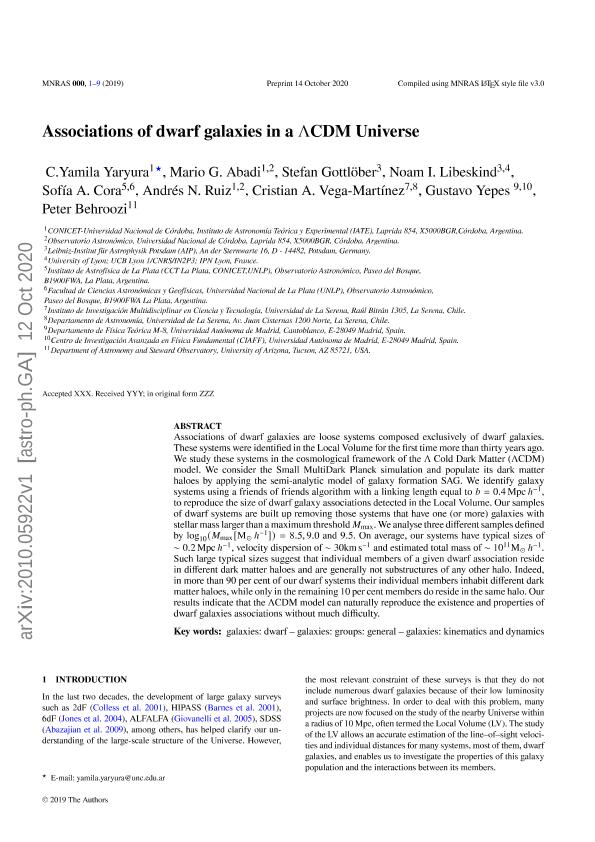Mostrar el registro sencillo del ítem
dc.contributor.author
Yaryura, Claudia Yamila

dc.contributor.author
Abadi, Mario Gabriel

dc.contributor.author
Gottlöber, Stefan
dc.contributor.author
Libeskind, Noam I.
dc.contributor.author
Cora, Sofia Alejandra

dc.contributor.author
Ruiz, Andrés Nicolás

dc.contributor.author
Vega Martínez, Cristian Antonio

dc.contributor.author
Yepes, Gustavo
dc.contributor.author
Behroozi, Peter
dc.date.available
2021-09-20T18:03:24Z
dc.date.issued
2020-10
dc.identifier.citation
Yaryura, Claudia Yamila; Abadi, Mario Gabriel; Gottlöber, Stefan; Libeskind, Noam I.; Cora, Sofia Alejandra; et al.; Associations of dwarf galaxies in a λCDM Universe; Wiley Blackwell Publishing, Inc; Monthly Notices of the Royal Astronomical Society; 499; 4; 10-2020; 5932-5940
dc.identifier.issn
0035-8711
dc.identifier.uri
http://hdl.handle.net/11336/140912
dc.description.abstract
Associations of dwarf galaxies are loose systems composed exclusively of dwarf galaxies. These systems were identified in the Local Volume for the first time more than 30 yr ago. We study these systems in the cosmological framework of the λ cold dark matter (λCDM) model.We consider the Small MultiDark Planck simulation and populate its dark matter haloes by applying the semi-analytic model of galaxy formation SAG. We identify galaxy systems using a friends-of-friends algorithm with a linking length equal to b = 0.4Mpc h-1to reproduce the size of dwarf galaxy associations detected in the Local Volume. Our samples of dwarf systems are built up removing those systems that have one or more galaxies with stellar mass larger than a maximum thresholdMmax.We analyse three different samples defined by log10(Mmax[M⊙ h-1]) = 8.5, 9.0, and 9.5. On average, our systems have typical sizes of ∼ 0.2Mpc h-1, velocity dispersion of ∼ 30km s-1, and estimated total mass of ∼ 1011M⊙ h-1. Such large typical sizes suggest that individual members of a given dwarf association reside in different dark matter haloes and are generally not substructures of any other halo. Indeed, in more than 90 per cent of our dwarf systems their individual members inhabit different dark matter haloes, while only in the remaining 10 per cent members do reside in the same halo. Our results indicate that the λCDM model can naturally reproduce the existence and properties of dwarf galaxies' associations without much difficulty.
dc.format
application/pdf
dc.language.iso
eng
dc.publisher
Wiley Blackwell Publishing, Inc

dc.rights
info:eu-repo/semantics/openAccess
dc.rights.uri
https://creativecommons.org/licenses/by-nc-sa/2.5/ar/
dc.subject
GALAXIES: DWARF
dc.subject
GALAXIES: GROUPS: GENERAL
dc.subject
GALAXIES: KINEMATICS AND DYNAMICS
dc.subject.classification
Astronomía

dc.subject.classification
Ciencias Físicas

dc.subject.classification
CIENCIAS NATURALES Y EXACTAS

dc.title
Associations of dwarf galaxies in a λCDM Universe
dc.type
info:eu-repo/semantics/article
dc.type
info:ar-repo/semantics/artículo
dc.type
info:eu-repo/semantics/publishedVersion
dc.date.updated
2021-09-06T15:10:14Z
dc.identifier.eissn
1365-2966
dc.journal.volume
499
dc.journal.number
4
dc.journal.pagination
5932-5940
dc.journal.pais
Reino Unido

dc.journal.ciudad
Londres
dc.description.fil
Fil: Yaryura, Claudia Yamila. Consejo Nacional de Investigaciones Científicas y Técnicas. Centro Científico Tecnológico Conicet - Córdoba. Instituto de Astronomía Teórica y Experimental. Universidad Nacional de Córdoba. Observatorio Astronómico de Córdoba. Instituto de Astronomía Teórica y Experimental; Argentina
dc.description.fil
Fil: Abadi, Mario Gabriel. Consejo Nacional de Investigaciones Científicas y Técnicas. Centro Científico Tecnológico Conicet - Córdoba. Instituto de Astronomía Teórica y Experimental. Universidad Nacional de Córdoba. Observatorio Astronómico de Córdoba. Instituto de Astronomía Teórica y Experimental; Argentina
dc.description.fil
Fil: Gottlöber, Stefan. Leibniz Universitat Hannover; Alemania
dc.description.fil
Fil: Libeskind, Noam I.. Leibniz Universitat Hannover; Alemania
dc.description.fil
Fil: Cora, Sofia Alejandra. Consejo Nacional de Investigaciones Científicas y Técnicas. Centro Científico Tecnológico Conicet - La Plata. Instituto de Astrofísica La Plata. Universidad Nacional de La Plata. Facultad de Ciencias Astronómicas y Geofísicas. Instituto de Astrofísica La Plata; Argentina
dc.description.fil
Fil: Ruiz, Andrés Nicolás. Consejo Nacional de Investigaciones Científicas y Técnicas. Centro Científico Tecnológico Conicet - Córdoba. Instituto de Astronomía Teórica y Experimental. Universidad Nacional de Córdoba. Observatorio Astronómico de Córdoba. Instituto de Astronomía Teórica y Experimental; Argentina. Universidad Nacional de Córdoba. Observatorio Astronómico de Córdoba; Argentina
dc.description.fil
Fil: Vega Martínez, Cristian Antonio. Consejo Nacional de Investigaciones Científicas y Técnicas. Centro Científico Tecnológico Conicet - La Plata. Instituto de Astrofísica La Plata. Universidad Nacional de La Plata. Facultad de Ciencias Astronómicas y Geofísicas. Instituto de Astrofísica La Plata; Argentina. Universidad de La Serena; Chile
dc.description.fil
Fil: Yepes, Gustavo. Universidad Autónoma de Madrid; España
dc.description.fil
Fil: Behroozi, Peter. George Mason University. School Of Physics. Astronomy And Computational Sciences; Estados Unidos
dc.journal.title
Monthly Notices of the Royal Astronomical Society

dc.relation.alternativeid
info:eu-repo/semantics/altIdentifier/url/https://academic.oup.com/mnras/advance-article/doi/10.1093/mnras/staa3197/5936641
dc.relation.alternativeid
info:eu-repo/semantics/altIdentifier/doi/http://dx.doi.org/10.1093/mnras/staa3197
Archivos asociados
